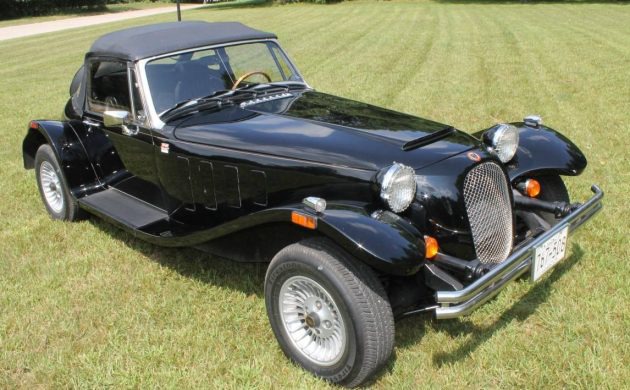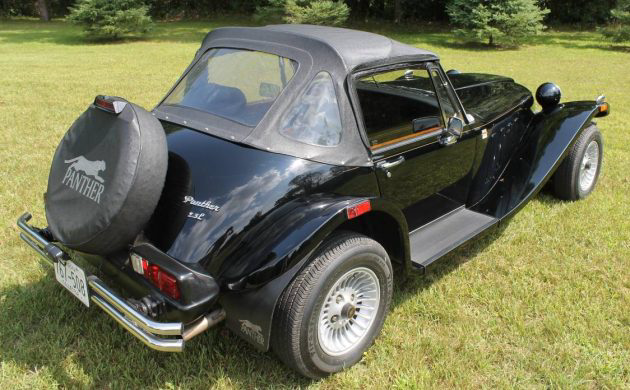9k Original Miles: 1986 Panther Kallista
It would be easy to look at this 1986 Panther Kallista and believe it is just another of the numerous kit cars that flooded the market during the 1970s and 1980s. However, it is far more than that. The Kallista is a handbuilt British sports car featuring a bespoke steel chassis and aluminum panels. Its drivetrain components are primarily from the Ford parts bin, making these classics cheap and easy to maintain. This 1986 Kallista needs a new home, and I must say a big thank you to Barn Finder Tony P for spotting it.
Depending on who you believe, Robert Jankel was either a visionary genius or a man with ambitions that far outstripped his ability. Originally a fashion designer, he became determined to enter the car industry after selling a Rolls-Royce he had restored with his own hands. He formed Panther Westwinds in 1972, planning to produce handbuilt premium vehicles for discerning buyers. This creative thinking resulted in cars like the Rio, a pint-sized Rolls-Royce clone based on the Triumph Dolomite. Far more ambitious was the Panther 6. Jankel chose its name because it featured 50% more wheels than the average buyer expected to find on a two-seat Roadster. The rear-mounted twin-turbocharged V8 started life in a Cadillac, acting like a pendulum during spirited cornering. Many believe that the “6” would have been better served if its configuration had placed the pair of additional wheels at the back to provide more mechanical grip. The price proved prohibitive, and only two examples of the “6” left the factory. Panther released the Kallista in 1982 as its replacement for the successful Lima model. It featured a bespoke steel chassis clad in aluminum panels, with styling reminiscent of classic Morgans and other British sports cars. This Kallista is a genuine survivor, finished in stunning Black. There is little to criticize about its condition, with the paint shining richly and the panels as straight as an arrow. Rust isn’t an issue, and the Black soft-top is as tight as a drum. The trim and glass are exceptional, and the turbine wheels are free from stains and other defects.
The Kallista’s exterior looks exotic, but it hides a drivetrain that is quite humble. Buyers faced several engine choices, with this car featuring Ford’s 2.3-liter four producing 88hp and 122 ft/lbs of torque. Panther derived the four-speed manual transmission from the same source, and while it doesn’t sound like the recipe for excitement, the Kallista’s curb weight of 2,335 lbs made it surprisingly spirited. However, the low center of gravity and relatively large tires for a vehicle of this size allow it to grip tenaciously in the turns, making the Kallista a blast to drive on winding roads. The seller states it has a genuine 9,131 miles on the clock without mentioning verifying evidence. They don’t supply information on how it runs or drives, but their use of the word “excellent” in the description suggests the news should be positive.
One look at the interior confirms that the Kallista isn’t a kit car. The new owner receives acres of Black leather and walnut veneer, and the overall condition is impressive. There is no visible wear or signs of abuse, and the walnut hasn’t cracked or delaminated. The dash features an array of gauges typical of traditional British sports cars, and the Le Carra timber wheel somehow feels “right” inside this classic. There are no aftermarket additions, with this Panther retaining the factory air conditioning and Philips AM/FM radio/cassette player.
Robert Jankel launched Panther Westwinds in 1972 with a bold vision of producing high-quality, handbuilt classics that appealed to discerning buyers. Unfortunately, the company struggled financially, closing its doors in 1990. The Kallista was its volume-selling model in the 1980s, but nobody knows how many rolled out of the factory before the curtain fell. The seller believes that around 185 of these classics landed in North America, which sounds plausible. This 1986 Kallista is a survivor that the seller listed here on Craigslist in Nisswa, Minnesota. They set their price at $26,980, placing it at the upper end of the market. Its condition probably justifies that figure, and it will be fascinating to see whether it finds a new home. Do you think it will?
Auctions Ending Soon
 2006 Ford Mustang Saleen S281 SCBid Now1 days$15,000
2006 Ford Mustang Saleen S281 SCBid Now1 days$15,000
 2002 Subaru Impreza WRXBid Now4 days$100
2002 Subaru Impreza WRXBid Now4 days$100
 1975 Chevrolet Corvette ConvertibleBid Now4 days$3,000
1975 Chevrolet Corvette ConvertibleBid Now4 days$3,000
 1964 Ford F-100 Camper CustomBid Now4 days$500
1964 Ford F-100 Camper CustomBid Now4 days$500
 2006 Jeep Wrangler SportBid Now6 days$4,000
2006 Jeep Wrangler SportBid Now6 days$4,000






Comments
Another MG Midget bites the dust. Not bad overall but I wonder why they didn’t use a blow up small spare tire tucked inside instead of a huge tire hung on the back. Had the same thought when I saw the car in the ’80s at a car show.
My latest daily driver didn’t even offer the option of a spare tire. Just ditch that heavy spare and carry a can of tire sealant. Any blowouts larger than that, call the auto club for towing.
@bobhess. I’m sure you are far more knowledgeable than I re classic cars but I don’t think that the Kallista came from an MG Midget as it is a far larger car than the MG. A friend of mine in South Africa also had one which I’m fairly certain had a Ford V6 engine.
Solosolo, take a close look at the doors and windshield, identical to a MkII-III MG Midget. These and a few other neoclassics apparently used a Midget’s central passenger cell for reasons we can only speculate about, “roomy” certainly not among them.
Maybe they were cheap and plentiful to obtain in good shape from junkyards at the time, easy to mount on a custom chassis and blend harmoniously into neoclassic-styled nose and tail sections for a narrow “torpedo” style body.
I had wondered if they were using British Motor Heritage reproduction bodyshells, but BMH didn’t start reproducing Midget shells until 1991.
They used only the passenger section which got them a firewall, doors and seats, and a windshield to hook the top to. Go on the Craigslist ad and look at the open left door and you can see the same hinges that originally came on the Bugeye Sprite. The triple windshield wipers is another clue that it’s a late model Midget center section. Very well done and they weren’t the only ones to build a car that way.
Bob, between this, the Clenet, the Arkley, and who knows how many other backyard butchers, Spridgets were commonly sacrificed to the spirit of “Here, hold my beer.”
I regretfully admit to being one of those in my foolish youth.
I’ve commented here before as a former Clenet employee. I only worked on the Series II. The Series I cars (250) used the MG “tub”, as I recall, as a way to comply with FMVSS door lock/latch integrity Federal crash testing- the certifications had already been issued. The “tub” was integrated into custom fabricated steel body panels fore and aft. The fenders were the only fiberglass on the vehicle. This same process was used on the Second Series cars, except that brand new VW Cabriolet body components were purchased factory direct and integrated with fabricated steel panels. Far from being “backyard butchers”, we had a multi-million dollar factory, with a production line and work stations where you would complete your “phase” and then roll the car down the line (the owner and some of management were Detroit veterans). There was even a rumored Series III car, consisting of a new Australian Ford roller with a Porsche engine. I left prior to their closure. I have read that they got over extended with a primary financier, who eventually took control, leading to its eventual demise.
A cousin of mine drove a Panther. Interesting car…but….. No sure $26K is a good number for this vehicle…. you gotta really want one especially if no one really knows them………..Good luck!!
Wire wheels and wide whites would totally transform this car. Those wheels are just wrong for the body style.
Wire wheels were my first thought when I saw the photos! Not so sure I would go with the wide whites though.
Its just the Midget/ Sprite doors! I guess they would have used new ones, so no Spridget hat to bite the dust!
regards Thomas
Go read John Eder’s comment above.
A case could be made that this is a midget looking at the cowl. Three wiper blades!
agreed, loose the spare, wanna see the rear deck. Can almost now & it looks nice. The Lima engine can B jazzed (is a x-flow) and efi/turboed might B nice/fit.
To my eye, the trunk is too truncated
I would find a nice Crossfire versus this type of vehicle – cheaper and way better and will run laps around these things.